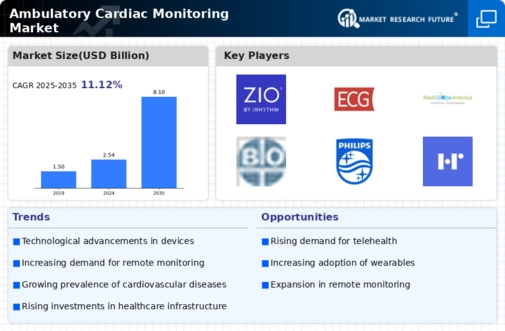Increasing Prevalence of Cardiac Diseases
The rising incidence of cardiac diseases is a primary driver for the Ambulatory Cardiac Monitoring Market. As cardiovascular conditions become more prevalent, the demand for effective monitoring solutions escalates. According to recent statistics, cardiovascular diseases account for a substantial percentage of global mortality rates, prompting healthcare providers to seek advanced monitoring technologies. This trend is likely to continue, as the aging population and lifestyle changes contribute to the growing burden of heart-related ailments. Consequently, the Ambulatory Cardiac Monitoring Market is expected to expand, driven by the need for continuous and remote monitoring solutions that can enhance patient outcomes and reduce hospital visits.
Growing Awareness of Preventive Healthcare
There is a notable shift towards preventive healthcare, which is driving the Ambulatory Cardiac Monitoring Market. As individuals become more health-conscious, there is an increasing demand for tools that facilitate early detection of cardiac issues. Educational campaigns and public health initiatives are raising awareness about the importance of regular monitoring and lifestyle management. This trend is likely to encourage more patients to seek ambulatory monitoring solutions, thereby expanding the market. The Ambulatory Cardiac Monitoring Market stands to gain from this growing emphasis on prevention, as healthcare providers look to implement proactive strategies to manage cardiovascular health.
Rising Demand for Remote Patient Monitoring
The increasing preference for remote patient monitoring is significantly influencing the Ambulatory Cardiac Monitoring Market. Patients and healthcare providers are recognizing the benefits of monitoring cardiac health from home, which reduces the need for frequent hospital visits. This trend is particularly relevant in managing chronic conditions, where continuous monitoring can lead to better health outcomes. The market is projected to grow as more healthcare systems adopt remote monitoring solutions, driven by the need for cost-effective and efficient care. The Ambulatory Cardiac Monitoring Market is likely to see innovations that cater to this demand, enhancing patient engagement and adherence to treatment plans.
Technological Advancements in Monitoring Devices
Technological innovations play a crucial role in shaping the Ambulatory Cardiac Monitoring Market. The development of sophisticated monitoring devices, such as portable ECG monitors and smartphone-integrated wearables, has revolutionized cardiac care. These advancements enable real-time data collection and analysis, facilitating timely interventions. The market is witnessing a surge in demand for devices that offer enhanced accuracy and user-friendliness. Furthermore, the integration of artificial intelligence and machine learning algorithms into monitoring systems is expected to improve diagnostic capabilities. As these technologies evolve, they are likely to drive the growth of the Ambulatory Cardiac Monitoring Market, providing healthcare professionals with valuable insights into patient health.
Regulatory Support for Innovative Monitoring Solutions
Regulatory bodies are increasingly supporting the development and adoption of innovative monitoring solutions within the Ambulatory Cardiac Monitoring Market. Initiatives aimed at streamlining the approval process for new devices and technologies are encouraging manufacturers to invest in research and development. This regulatory environment fosters innovation, allowing for the introduction of advanced monitoring systems that meet stringent safety and efficacy standards. As a result, the Ambulatory Cardiac Monitoring Market is expected to benefit from a wider array of products that can address diverse patient needs, ultimately enhancing the quality of cardiac care.


















Leave a Comment